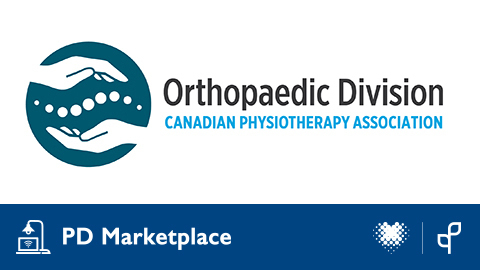Pregnancy-Related Pelvic Girdle Pain and Dysfunction

Pregnancy-Related Pelvic Girdle Pain and Dysfunction
1 hour
Orthopaedic Division Members: Check your email for the link to access this Webinar for FREE –>
Pregnancy-related pelvic girdle pain and dysfunction: An update on assessing the force closure mechanism of the pelvis (including the pelvic floor) for Orthopaedic physiotherapists
Description:
Pregnancy-related pelvic girdle pain (PRPGP) affects 70-80% of women and while most will recover, 50% will continue to experience urinary incontinence and/or pelvic organ prolapse in association with their low back and PRPGP.
All clinicians who treat postpartum women need to be aware of this statistic and have basic tools for assessment of the pelvic floor and to know when to refer to a pelvic health physiotherapist. This webinar will provide these introductory tools and is intended for orthopaedic physiotherapists.
Objectives:
At the end of this webinar, the participant will have an introductory understanding of the following:
- Pregnancy-related PGP – prevalence during pregnancy and after
- Urinary incontinence prevalence and course through life
- Pelvic organ prolapse prevalence and risk factors
- Relationship between PGP and urinary incontinence & POP
- Requirements for a functional pelvic girdle, with urinary continence and pelvic organ support Form and force closure mechanisms for the pelvic girdle and impact of pain on these mechanisms
- Why there are no recipes for PRPGP and skilled clinical reasoning is still our best approach
- Common impairments in the muscles of the abdominal canister related to pregnancy
- Evidence-informed, clinically reasoned assessment for PRPGP, UI and POP
- Active & passive mobility and control tests for the ISJ
- Assessment of the abdominal wall and multifidus – NOT the focus of this lecture but some key points
- Assessment of the pelvic floor – some tips for orthopaedic physiotherapists
- What else can you learn to do to add more tools to your assessment and treatment toolbox for PRPGP, UI and POP?
Price:
Free for Orthopaedic Division Members, $10 for CPA members & $20 for non Members
Webinar Details:
- Date: Tuesday June 1st, 2021
- Time: 8:00pm - 9:00pm EST
- Speaker: Diane Lee
Speaker Bio: Diane Lee, BSR, FCAMPT, CGIMS, Clinical Specialist in Women’s Health
Diane is a UBC graduate in the field of rehabilitation medicine. She is a fellow of the Canadian Academy of Manipulative Therapy (CAMT), certified practitioner of intramuscular stimulation (Gunn IMS) and certified by the Canadian Physiotherapy Association as a clinical specialist in Women’s Health. She was an instructor and chief examiner for CAMT for over 20 years. Diane is also the owner, director, and a practicing physiotherapist at Diane Lee & Associates, a private multi-disciplinary physiotherapy clinic in South Surrey, BC, Canada.
In addition, she is the principal instructor of Learn with Diane Lee (www.learnwithdianelee.com). She has been a keynote speaker at many conferences, has contributed chapters to several books and self-published the books The Thorax – An Integrated Approach and Diastasis Rectus Abdominis – A Clinical Guide for Those Split Down the Middle (www.learnwithdianelee.com). Her book, The Pelvic Girdle, was first published by Churchill Livingstone in 1989, is now in its 4th edition (2011) and has been translated into multiple languages.
A new edition of The Thorax – an integrated approach is currently at press with Handspring Publishing. She holds the North American patent for two sacroiliac belts, The Com-Pressor, and The Baby Belly Pelvic Support. With respect to research, she continues to investigate the behaviour of the abdominal wall in women with diastasis rectus abdominis.
The instructors

BSR, FCAMPT, CGIMS, RYT200
Diane graduated with distinction from the University of British Columbia with a Bachelor degree in the Science of Rehabilitation in 1976. She has been a member of the Canadian Physiotherapy Association since 1976 and a fellow of the Canadian Academy of Manipulative Therapy since 1981 (FCAMT). She completed certification in Intramuscular Stimulation (IMS) in 2001, Yoga teacher training in 2012, pelvic floor certification in 2013 and was recognized by the Canadian Physiotherapy Association as a clinical specialist in Woman’s Health in 2016.
She was an instructor and a chief examiner for the Orthopaedic Division of CPA’s fellowship examinations (CAMT) for over 20 years and has extensive experience in curriculum development both for the CAMT program and her own series of courses.
She is well published (books, chapters and journal articles) and the innovator of two pelvic support belts for which she holds the patent; The Com-Pressor and the Baby Belly Pelvic Support (www.babybellypelvicsupport.com).
Diane owns, directs and is a practicing physiotherapist at Diane Lee & Associates http://www.dianelee.ca. She has continued to maintain an on-going clinical practice for over 40 years and while she follows the research evidence closely, she draws from this deep clinical experience for her teaching and lecturing in the clinic, in Canada and internationally.
Diane has had the honour of collaborating with local, national and worldwide authorities to further her own education and integrates this knowledge into courses/models she teaches. Her combined clinical and education experience culminated in the co-development of The Integrated Systems Model for Disability & Pain (ISM), (Lee Diane & Lee Linda-Joy 2007 – 2013) the model she continues to teach and now solely evolve under the abbreviated title – the Integrated Systems Model – alongside her senior assistants from Diane Lee & Associates.

The Orthopaedic Division of the Canadian Physiotherapy Association helps our members improve their skills and service delivery through education, resources and networking.
With a reputation built on excellent instructors and a rigorous examination process, the Division offers tailored online e-learning, webinars, workshops, courses and practice resources for members at a reasonable cost and time commitment. Members learn from other practicing physiotherapists and stay current with a regularly updated curriculum and program delivery based on providing quality and modern treatment.
